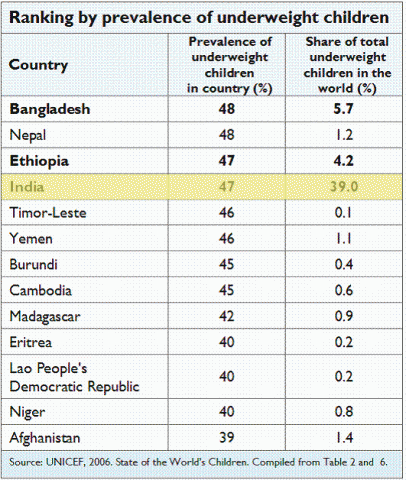
Child malnutrition – as measured by poor child growth – is an important indicator for monitoring population nutritional status and health. In 2014, about 16%, or 95 million children under five years of age in less developed regions were underweight (low weight-for-age according to the WHO child growth standards). Underweight prevalence is highest in the UN region of Southern Asia (28%), followed by Western Africa (20%), Oceania and Eastern Africa (both 18%) and South-Eastern Asia (16%), Middle Africa (15%), and Southern Africa (11%). Prevalences below 10% for 2014 are estimated for the UN regions of Eastern, Central and Western Asia, Northern Africa and all Latin America and the Caribbean regions. Children living in rural areas are more likely to be underweight than those living in urban areas. Childhood malnutrition, including fetal growth restriction, suboptimum breastfeeding, stunting, wasting and Vitamin A and zinc deficiencies, is an underlying cause of death in an estimated 45% of all deaths among children under five years of age.
Trends
Globally, the proportion of children under five years old who were underweight declined by 11 percentage points between 1990 and 2014, from 25% to 14%. While Africa has experience the smallest relative decrease, with underweight prevalence of 16% in 2014 down from 23% in 1990, in Asia for the same period it reduced from 32% to 18% and in Latin America and the Caribbean from 8% to 3%. This means Asia is likely to, and Latin America and the Caribbean will meet the MDG, while Africa is expected to fall short, reaching about only half of the targeted reduction. Even if Asia overall might meet the MDG, to halve the 1990 rate of underweight, rates continues to be high in Southern Asia (28%). This combined with large population, means that more than half of all underweight children live in Southern Asia (51 million out of the global estimate of 95 million in 2014).
Source: WHO
 FR
FR EN
EN AR
AR








